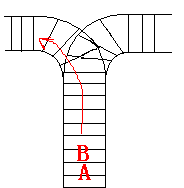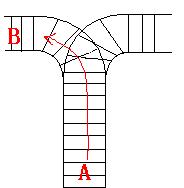Train Problem I
Time Limit: 2000/1000 MS (Java/Others) Memory Limit: 65536/32768 K (Java/Others)Total Submission(s): 21854 Accepted Submission(s): 8269
Problem Description
As the new term comes, the Ignatius Train Station is very busy nowadays. A lot of student want to get back to school by train(because the trains in the Ignatius Train Station is the fastest all over the world ^v^). But here comes a problem, there is only one railway where all the trains stop. So all the trains come in from one side and get out from the other side. For this problem, if train A gets into the railway first, and then train B gets into the railway before train A leaves, train A can't leave until train B leaves. The pictures below figure out the problem. Now the problem for you is, there are at most 9 trains in the station, all the trains has an ID(numbered from 1 to n), the trains get into the railway in an order O1, your task is to determine whether the trains can get out in an order O2.






Input
The input contains several test cases. Each test case consists of an integer, the number of trains, and two strings, the order of the trains come in:O1, and the order of the trains leave:O2. The input is terminated by the end of file. More details in the Sample Input.
Output
The output contains a string "No." if you can't exchange O2 to O1, or you should output a line contains "Yes.", and then output your way in exchanging the order(you should output "in" for a train getting into the railway, and "out" for a train getting out of the railway). Print a line contains "FINISH" after each test case. More details in the Sample Output.
Sample Input
3 123 321 3 123 312
Sample Output
Yes. in in in out out out FINISH No. FINISHFor the first Sample Input, we let train 1 get in, then train 2 and train 3. So now train 3 is at the top of the railway, so train 3 can leave first, then train 2 and train 1. In the second Sample input, we should let train 3 leave first, so we have to let train 1 get in, then train 2 and train 3. Now we can let train 3 leave. But after that we can't let train 1 leave before train 2, because train 2 is at the top of the railway at the moment.HintHintSo we output "No.".
worry的时候怎么改都改不对!看别人的代码AC了怎么朝自己写的方向改都改不成错的!哎。。。。。。
终于找着worry的原因了,没有考虑到栈下标是负的时候不应该赋值,其他情况都对,都对。。。。
还有一种情况就是,s1和s2都要判断是否为空值,即两个数组都要判断是否出界
刚开始我是拿s2数组作为循环准则的,如果s2循环完了,就完了,但是少考虑了这么一种情况,s1全部入栈完了但是还没有找到匹配s2的
先是worry的代码:
#include <iostream> #include <string.h> #include <memory.h> using namespace std; int c[50]; char s1[20],s2[20],stack[20]; int main(void) { int n; while(cin>>n>>s1>>s2) { if(strlen(s1)!=strlen(s2)) { cout<<"No."<<endl; cout<<"FINISH"<<endl; continue; } memset(c,0,sizeof(c)); memset(stack,0,sizeof(stack)); stack[0]=s1[0]; c[0]=1; int top=0,i=0,j=0,k=0; while(k<n&&i<n) { while(stack[top]!=s2[k]) { stack[++top]=s1[++i]; c[++j]=1; } if(stack[top]==s2[k]) { ++k; c[++j]=2; top--; } /* else { stack[++top]=s1[++i]; c[++j]=1; }*/ } if(j==2*n-1) { cout<<"Yes."<<endl; for(int i=0;i<=j;i++) { if(c[i]==1) cout<<"in"<<endl; if(c[i]==2) cout<<"out"<<endl; } cout<<"FINISH"<<endl; } else { cout<<"No."<<endl; cout<<"FINISH"<<endl; } } return 0; }
这是AC的代码:
脑袋混沌的孩纸伤不起啊#include <iostream> #include <string.h> #include <memory.h> using namespace std; int c[50]; char s1[20],s2[20],stack[20]; int main(void) { int n; while(cin>>n>>s1>>s2) { memset(c,0,sizeof(c)); stack[0]=s1[0]; c[0]=1; int top=0,i=0,j=0,k=0; while(k<n&&i<n) { if(stack[top]==s2[k]) { ++k; c[++j]=2; top--; } else { stack[++top]=s1[++i]; c[++j]=1; } } if(k==n) { cout<<"Yes."<<endl; for(int i=0;i<=j;i++) { if(c[i]==1) cout<<"in"<<endl; if(c[i]==2) cout<<"out"<<endl; } cout<<"FINISH"<<endl; } else { cout<<"No."<<endl; cout<<"FINISH"<<endl; } } return 0; }






















 1412
1412

 被折叠的 条评论
为什么被折叠?
被折叠的 条评论
为什么被折叠?








